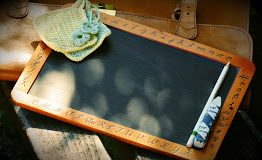Happy New Year!
I’m excited to head back into the classroom after a nice long holiday break and I’m filled with inspiration that will (hopefully) nourish my classroom for the remainder of the school year (or at least until Spring Break.)
Though I’m usually filled with those new, fresh start feelings at the beginning of the school year, I just can’t help but join in and jump on the new beginnings bandwagon in January. Truly, after the deep reflection and introspection that happens in December, January is a perfect time for getting intentional and inspired.

This year, I’ve done lots of personal goal-setting, but I’m also looking to renew and refresh my professional life. And, as is my habit, I take a natural turn to the practical.
In my teaching life, I have found my biggest tools to be habit and rhythm. In fact, if there is something I want to make sure I accomplish over the course of the school year, the best thing I can do is to create a rhythm around it. Before I know it, the practice becomes a habit and I accomplish my goals.
I can think of countless examples of how systems have served me and my students. For just a couple, check out this post about our daily dictation practice and this one about last year’s “kid writing” rhythm.
So what are some of the systems you should look to set up in your classroom? Let’s take a look.
Classroom Management and Discipline Plan
I can’t tell you how many teachers come to me with questions and concerns about classroom management. Truly, when I began teaching it was my biggest concern and my greatest challenge.
Sometimes the thought of getting 28 students to cooperate and engage in their learning when they’d really rather be outside playing basketball is pretty overwhelming.
And even now, sometimes I look around the room and marvel at how well everyone is engaged and learning. I mean, what’s stopping them from throwing their pencils on the floor, staging a coup, and overthrowing their leader?
That’s why every teacher needs to have a solid classroom management plan.
And I don’t mean that you should have a rough idea in your mind of what you’re going to do and how you’re going to address various issues. I mean that you sit down at your computer and write it up.
What are the primary tools in your classroom management toolkit?
What do you believe to be important about managing your students?
How will you address those sticky situations?
How will you communicate with parents about it?
You should have well-thought through answers to these questions. With all of that thinking work done, you will feel more confident in your actions and better equipped to talk with parents about your classroom management approach.
Speaking of classroom management, I am releasing a free classroom management workshop video early next month. If you want to brush up on your classroom management skills, you can register for the workshop here.
Free Workshop: 3 Classroom Management Strategies Every Waldorf Teacher Needs to Know
Register Now!
Parent Communication Plan
This is another all-important topic that you need to think through ahead of time. What kind of communication will you be providing to your class parents? A well-informed parent is a happy parent and really, can you blame them?
These parents are trusting you with their most precious gift every day. If they do not ask questions and make sure that their child is being provided with the best experience, those parents are really not doing their job.
Your job is to let them know ahead of time that you’ve got them. You’re taking your job seriously, you love their child and you have a plan for helping them move forward into the future.
Reassuring parents in this way requires communication.
- What mode of communication will you use?
- How frequently will you communicate?
- What kind of information will communicate in what ways? Make sure you’re considering that some information is best relayed in person.
- Will you communicate the little positive moments, just as much as the concerning issues?
Think all of these questions through and write out a plan.
Record-Keeping and Feedback Plan
The last essential plan you need to make sure you write out in detail is how you will be keeping records and providing feedback. There are so many things to consider here, that you’ve just got to write it all out for yourself to keep it all straight.
The first thing to consider is who you will provide feedback to. For younger students, your feedback will be a positive gesture and a pat on the back. Middle schoolers need more formalized, even quantitative feedback.
But the feedback you provide to the students themselves is just the tip of the iceberg. You should keep records so you can measure your own progress, so you can report to your school administration and so you can provide parents with detailed information about their child’s progress.
As you head into the new year, double-check your rhythms for keeping records and providing feedback. Are you keeping up with the system that you set for yourself at the beginning of the school year? If not, how can you make it a more reliable part of your rhythm? Can you connect the task to an already established habit? Often our daily lives are so rhythmic that they can feel a bit monotonous. But the benefit of all of that monotony is that it makes it easier to fit challenging tasks into a regular rhythm.
Here’s a little example. My life is at its most rhythmic in the fall. There is something about the new school year that just gets the rhythm train going. After a summer of adventure and fresh daily experiences, I’m ready to settle in and have a little “same old, same old.”
So, just about every Sunday in the fall, my rhythm consists of the following:
- picking up my grocery order
- cooking a big pot of soup to provide lunches for the week
- doing laundry
- watching my favorite football team play (Go ‘hawks!)
All of those tasks combine to create a sensory experience that provides me with such delight. I hear the rumble of the washing machine. I smell the soup bubbling on the stove. And I listen to the familiar voices of the announcers commenting on my team’s latest score.
It used to be that Sundays were full of anticipation and worry as I prepared for the coming busy week. But these days, all of those things have come together to make Sundays my favorite day of the week.
So, with all of those pleasant things going on, it was an easy leap to incorporate my weekly planning. I’ll put the game on mute (or wait until halftime) and pull out my planner. I’m in such a positive space that I start thinking about the coming week with excitement. I get ideas about stories I want to tell. I enter meetings on my weekly planner. And I start thinking about the review activities we’ll be doing in class.
Before I know it, I’m generating a little list of things I want to communicate to my class parents and I’m writing out tasks on my to-do list.
Doing this weekly planning has become one of my favorite tasks! (It doesn’t hurt that I have a beautiful planner and pens that I just love.)
So, as you consider these systems that you need to think through and identify in your classroom work, think about ways you can incorporate them into activities and systems that already exist.
It’s a sure-fire way to make sure you’re covering all of your bases. Your students will be getting what they need. Your class parents will feel confident and reassured. And your job will be that much easier.





Thank you this was helpful. I have been teaching in traditional schools for 30 years and have just (last week) started on my Waldorf journey. I am challenged but excited to be learning new teaching strategies and methods. Janine South Africa